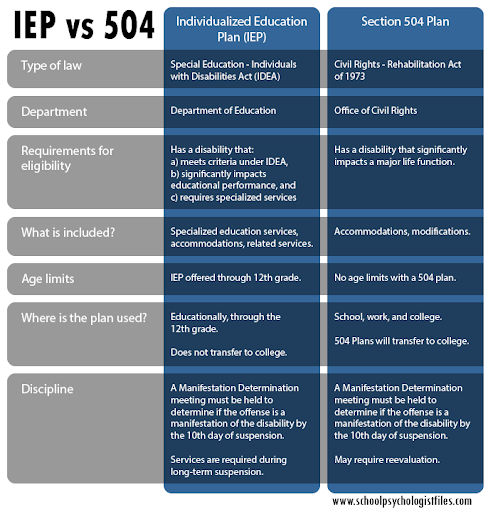…. …. . 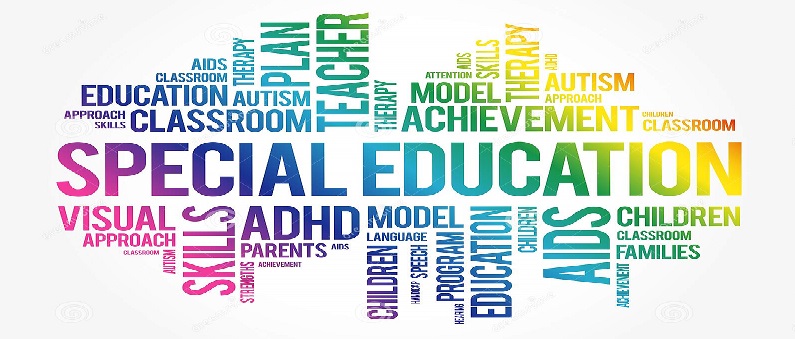
An individualized education program, or IEP, is a written plan that specifies goals and objectives for learning for students in the public school system that have been identified as having a disability. IEPs are mandated for students with disabilities by the Individuals with Disabilities Education Act (IDEA) of 2004. Each IEP is prepared by a team and is tailored to meet the individual needs of each student. The following charts will review some of the important points regarding the IEP process in public schools.
Before a student receives special education services, he or she must go through a process of intervention that documents the problems the student is having in the regular education setting. This process is called Response to Intervention, or RTI. The RTI process is completed using a three tiered system that is similar to the Prevention Stages reviewed in Module 1. This process usually occurs over the course of one grading period, such as one quarter or one trimester. Parents have the right to request a special education evaluation at any time during this process.
| Tier | Description | Example | Photo/Video |
| Tier 1 | Group Interventions – changes are made to regular classroom instruction that benefit all students, including those identified as “at risk”. -regular screenings are completed to identify students who may be at risk for learning difficulties. -changes are made to the classroom set-up and/or methods of instruction to benefit all students, including those at risk. -supplemental instruction for students identified as at risk is provided in the regular classroom during instruction time. |
A teacher uses a classroom audio system while lecturing to her students, improving the ability of all the students to be able to hear and attend to task. This includes two students in the classroom who have been identified as at risk for learning. | A video presentation of Handwriting Without Tears, a handwriting curriculum developed by an occupational therapist. The curriculum acts as a Tier 1 intervention by presenting handwriting through multiple learning styles and activities. |
| Tier 2 | Targeted Interventions – students who have not responded to Tier 1 interventions are provided more intensive instruction in small groups, in addition to regular classroom instruction. -usually provided in the areas of reading and math, especially for grades kindergarten through third. |
A paraprofessional works on math with a group of three first graders in the corner of the classroom during math instruction. | A teacher provides small group reading instruction to English Language Learners, using visual, verbal, and movement teaching methods. |
| Tier 3 | Intensive Interventions – students who have not responded to Tier 1 and Tier 2 interventions receive intensive 1:1 instruction to target skill deficits. -if a student does not respond to Tier 3 intervention, the student is referred for comprehensive evaluation to determine eligibility for special education services. |
A second grade student works 1:1 with an RTI teacher in a separate room to learn reading skills. | A boy with Down syndrome receives instruction in his regular education classroom with Tier 3 intervention methods provided by an instructional aide. |
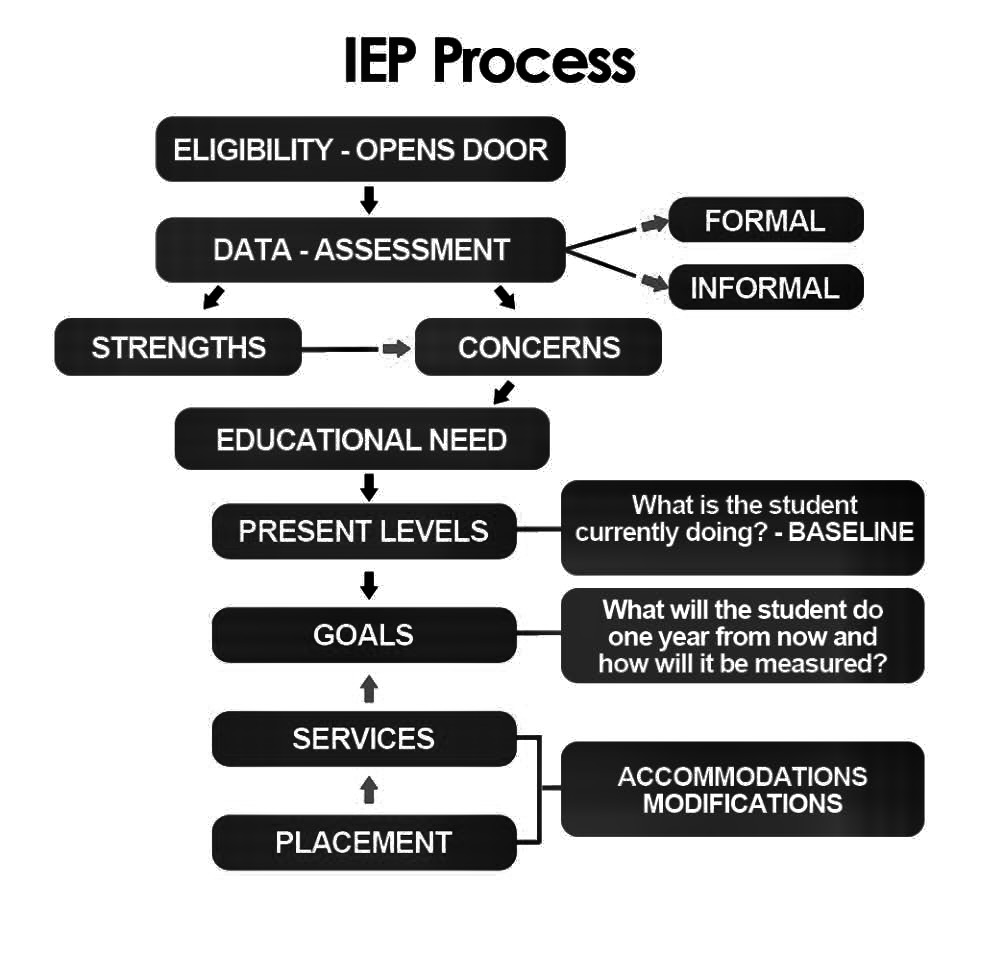
The process of referral for and completion of the evaluation for special education follows a specific sequence.
| Step | Description | Who is Responsible | Timeline |
| Referral for Evaluation | A referral is made for evaluation to determine if the student has a disability. -usually made by a teacher or parent -a notice is sent to the parent that the referral was received. -occupational therapy services may be included in the referral, but the referral must be for evaluation to determine eligibility for special education services. |
The Referral Form must be completed by the person making the referral. This form is turned in to the special education office. Special education staff members are then responsible for notifying the parent that the referral was received. | The referral is made after the student shows no or limited response to the RTI process. |
| Consent to Evaluate | Special education staff members review existing data regarding the student’s performance in school. They determine if additional testing is required before a decision may be made regarding eligibility for special education services. The student’s parent or guardian must sign a form consenting to the special education evaluation, including additional tests.
–If a state requires a physician’s prescription to provide services in the public schools, a prescription must be obtained from the student’s physician before occupational therapy services can be initiated. Not all states require a physician’s prescription for occupational therapy services in public schools. |
Each special education staff member is responsible for reviewing the existing data and submitting additional test required. The special education office is responsible for completing and sending the consent form to the parent. The parent is responsible for signing and returning the form or notifying the special education office that he or she will not consent to the evaluation. | Within 15 days of receipt of the referral form. |
| Testing | Once consent from a parent or guardian is received, special education staff members proceed with completing the approved tests with the student. | Each special education staff member must complete the tests they specified on the consent form. -each staff member evaluating the student should use assessment tools that compare the student’s functional status to normative data. -each staff member should determine baselines for the skills to be addressed in the IEP. |
Testing must be completed within 60 calendar days of receiving the signed consent form. |
| Determination of Disability | Once testing is completed, the special education evaluation team meets with the parent or guardian to discuss test results. -Each evaluator presents test results to the team. -Based on the test results, the team decides whether or not the student qualifies as a student with a disability. -Disability categories are reviewed below. -An IEP may or may not be recommended, based on the evaluation results. |
The IEP team, consisting of the parent or guardian, the local education agency (LEA) representative, the special education teacher, the regular education teacher, all related service personnel who have conducted testing, and any other staff or family members deemed necessary to the evaluation process. –occupational therapy is always considered a related service -may include county social workers, autism workers, child care providers, etc. -parents may request to have other family members or outside providers included in the IEP process. |
Within 60 calendar days of receiving the signed consent form. |
| Development of the Individualized Education Plan (IEP) | The IEP team develops the IEP for the student. This may be done immediately following the determination of disability, or may be completed during a separate meeting. -Parents may take time after the evaluation meeting to review the test results and consider the recommendations of the team. -Parents have the right to refuse special education services for their child if they do not agree with the plan presented. Parents also have the right to stop the evaluation and IEP process at any time. -The parts of the IEP are reviewed in a separate chart. |
The IEP team. At a minimum, the IEP team must include the parent or guardian, the regular education teacher, the special education teacher or speech therapist, the LEA representative. After the student is age 16 (younger in some states), the student may also attend the IEP meeting if he or she is able. The IEP cannot be developed or revised if these core members are not present. Related service personnel and others involved in the IEP process may be present, but are not required to develop or revise the IEP. | Within 30 days of the determination of disability. |
Disability in education is determined differently than disability in medical settings. A medical diagnosis is not necessary to determine disability in public schools. The team that conducts the student’s evaluation for special education services determines whether or not a student has a disability based on a set of criteria specified by IDEA 2004. To qualify, a student must meet criteria specified under each disability category. While the wording may vary slightly from state to state, the disability categories for public education are as follows:
A student may qualify for special education services under more than one disability category. When this is the case, the evaluation team must determine which category is primary, causing most of the student’s problems accessing public education, and which category is secondary. For example, a student may be determined to have a primary diagnosis of traumatic brain injury and a secondary diagnosis of speech/language impairment.
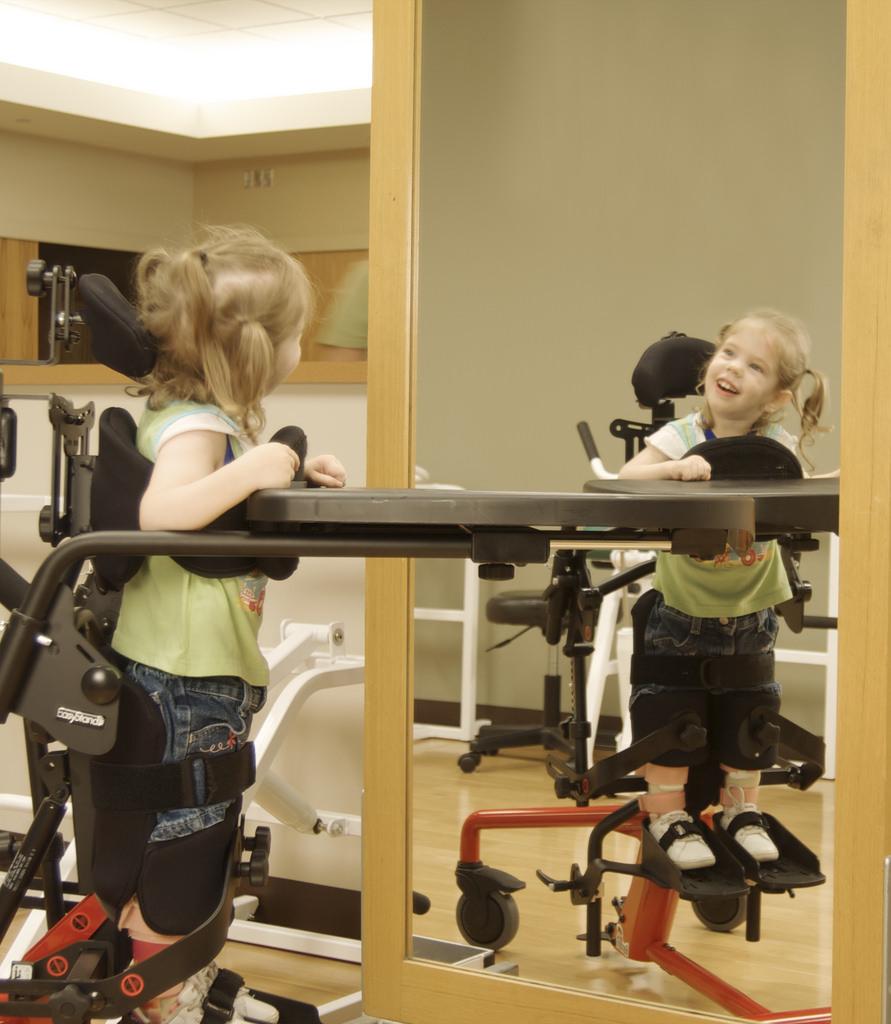
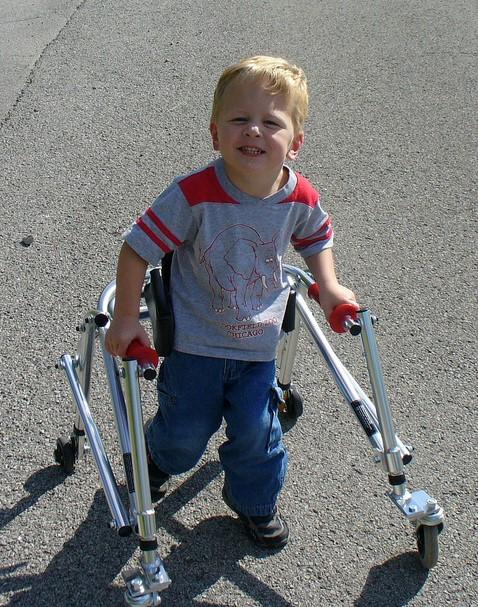
The IEP is written by the team of school staff responsible for implementing a student’s special education program. All components of the IEP may be addressed by all staff members, but some members are more qualified to implement certain parts of the IEP and those staff members take the lead for those sections.
| Part | Description | Example |
| Invitation to a Meeting of the Individualized Education Program Team | A notice to all the members of an IEP team regarding the date and time of the IEP meeting. The student’s parents or guardian must be able to attend this meeting or must give permission for the meeting to proceed without their presence. –parents may attend the IEP meeting via phone or video conference. –school staff may attend the IEP meeting via phone or video conference. -supplemental requests may be made to allow representatives from outside agencies or from local birth to three programs to attend the IEP meeting. -members of the IEP team who are unable to attend the meeting must get signed permission from the student’s parents to be absent from the meeting. |
The occupational therapist at a public school receives a notice for an IEP meeting for one of her students. The meeting is scheduled when she is at another school, but the occupational therapist is able to arrange her schedule to allow her to attend via phone. |
| Cover Page | Lists the personal information of the student and student’s parents. States the purpose of the IEP meeting and lists the IEP team participants. | The cover page for a student’s IEP lists the purpose of the meeting as an annual IEP review. |
| Student’s strengths and parent concerns | A description of the student’s strengths according to IEP team members, as well as a specific list of parents’ concerns regarding the student’s performance in school. | At the IEP meeting, the speech therapist reports that one of the student’s strengths is that he is very cheerful and social. |
| Present Level of Performance (PLOP) | Descriptions of the student’s academic and functional performance in school as of the IEP meeting date. -each member of the IEP team contributes to the PLOP according to their area of expertise and experience with the student. -divided into academic performance areas and functional performance areas -special sections addressing literacy -if an existing IEP is being reviewed, it is important to report progress as compared to baseline data from the previous IEP. |
Under the functional performance section of the IEP, the occupational therapist reports that the student is currently able to tie his shoes with no physical assistance in 100% of attempts, but needs verbal reminders to tighten the laces. The therapist compares the present level of performance to the level of performance of the previous year, which was that the student could tie his shoes with no physical assistance in 20% of attempts. |
| Special Factors | Needs or conditions the student may have that may impede the student’s access to education. These special factors include the following: -behavior -whether or not the student is an English Language Learner (ELL) -visual impairment -communication needs that could impede learning -assistive technology needs |
In the special factors section of the IEP, under assistive technology, the occupational therapist lists an adapted keyboard and roller ball mouse for the student to use during typing. |
| Annual Goals | Specific, measurable goals that address the academic achievement or functional performance of the student in the public school setting. –goals should be unique, addressing the student’s needs as related to the disability –goals should be realistic and attainable within the time frame of the IEP –goals should address skills that are needed to function within the school setting. Goals related to tasks that only occur at home are not appropriate for the IEP. –goals should allow the student to progress toward academic standards for his or her grade level. –goals should allow the student to work toward participating in the school setting with non-disabled peers. –goals may be measured by setting specific short-term objectives or benchmarks. –the baseline for the new annual goal should be reported. This can be determined by assessment of data collected in treatment sessions and may also be reported in the present level of performance (PLOP). |
The occupational therapist writes an annual goal for a student as follows: The student will transition between classrooms in the school with no more than 2 redirections from distractions, using a hand held fidget toy, in 80% of observed attempts. The baseline for the goals is reported to be 0% of attempts. |
| Program Summary | The list of supports and services that the school will provide to help the student achieve the annual goals. The frequency, amount, location, and duration of supports and services are specified in this section. Supports and services include:-specially designed instruction – these include special education instruction, speech and language therapy to address a speech and language impairment, and adaptive physical education-related services – these include: -assistive technology -audiology -counseling -educational interpreting -medical services for diagnosis and evaluation -occupational therapy -orientation and mobility (for students with visual impairments) -physical therapy -psychological services -recreation -rehabilitation counseling services -school health services -school nurse services -school social work services -speech and language services (when related to a disability other than speech and language impairment) -transportation -other related services as specified by the IEP team -supplementary aides and services – these are services and supports that allow the student to spend the maximum amount of time possible in the educational setting with non-disabled peers. May include paraprofessional support, use of assistive technology, use of low tech adaptations, peer modeling, social stories, video modeling, etc.-program modifications and supports for school personnel – this includes any training or tools that school staff members require to be able to provide services to the student. |
Under related services in the program summary, the occupational therapist reports that the student will receive direct occupational therapy services once per week for 30 minutes in the regular education classroom and once per week for 30 minutes in the school therapy room for the duration of the IEP. |
| Assessments | If the student is able to participate in testing, school based and state assessments that the student is required to take must be listed. For each assessment, the IEP must state if the student is to take the assessment with or without accommodations. If the student requires accommodations, these must be listed. -if a student is unable to participate in testing, the IEP team must designate alternate assessment as the method of assessment for the student. |
In the IEP, a student is identified as able to take the ACT Plus Writing with accommodations. The accommodations are listed as extra time to complete reading and writing portions of the test, and to have the instructions for each section of the test read out loud. |
| Transition Services | Beginning at age 16, the IEP must include documentation addressing transition from public school to post-secondary school or employment. Goals for post-secondary education and employment must be specified. Goals for independent living must also be specified if needed. Services provided to address the transition goals are listed. Individual states are allowed to set the age of transition earlier than age 16, but not later. | To meet the goal of post-secondary school employment, the transition services page lists supported employment at a local gas station for 2 hours per week for an 11 grade student. |
| Changes to the IEP Without a Meeting | In certain circumstances, when minor changes to a student’s IEP are required, an IEP team member may discuss the required changes with the student’s parents and other team members without calling a meeting to review the IEP. If the team agrees, changes to the IEP may be made by completing the appropriate forms and documenting communication with other team members. | Since a student has met his IEP goal of writing reports legibly and no longer needs weekly occupational therapy services, the occupational therapist discusses the student’s status with his parents and other staff members and determines that consultation services for handwriting are warranted. She completes the portions of the IEP that document a decrease in frequency from 30 minutes twice per week to consultation services 15 minutes per month. |
| Extended School Year | Some students may require services when the regular school year is not in session to maintain skills they have acquired. Extended School Year services are provided when: -it is documented that a student has the potential to regress without services, to the point that the student will not regain skills within a 6 week period of resuming services -it is documented that the student is making rapid progress in a specific skill area and stopping services will hinder this progress A separate from listing services, frequencies, and duration for the Extended School year is included in the IEP. -Extended School Year services are intended to maintain the student’s status when school is not in session or continue the progress achieved at the end of the regular school year. New goals should not be addressed. |
The occupational therapist recommends Extended School Year services for a student with hemiplegia, since the student lost over 50% of his active range of motion in his affected arm over the summer and did not regain that range until January of the current school year. |
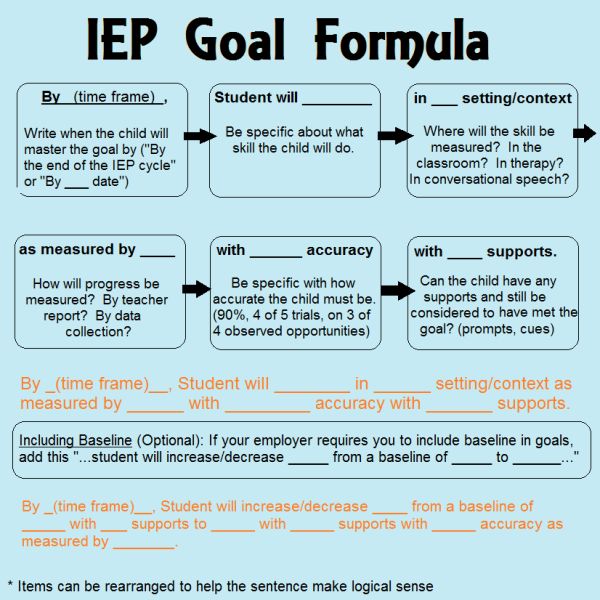
| Event | Action Taken | Example |
| Three-Year Re-evaluation: each student who receives special education services must be re-evaluated every three years to determine if the student still qualifies as a student with a disability under IDEA 2004. | 1. Each staff member who works with the child reports skill areas that continue to display deficits and submits requests for specific tests to re-evaluate the student’s disability status. Staff members may opt not to test if they have enough information to make a determination of disability without formal testing. 2. Permission to re-evaluate the student is obtained from the student’s parents or guardian. 3. Tests are completed and the results are reported to the parent in a similar format to the initial evaluation described above.4. The determination of continued disability is made similarly to the initial determination described above. |
The occupational therapist reports that the student continues to display deficits in fine motor and visual motor skills. She requests to administer the Bruninks-Oseretsky Test of Motor Proficiency, 2nd edition, to obtain normative data regarding the student’s fine motor and visual motor skills. The parent consents to testing. At the re-evaluation meeting, the occupational therapist reports that the student’s scores have increased by 10 percentile points, but the scores still fall below average when compared to norms for same age, same gender peers. The occupational therapist recommends continued occupational therapy services for fine motor and visual motor skills. |
| Dismissal from Special Education Services: the student has made sufficient progress in all skill areas that he or she can now access education in the regular education classroom. | 1. The student’s case manager contacts the student’s parents or guardian and explains that the student appears to now be able to access education in the regular education classroom and it is believed that the student no longer requires special education services. 2. A re-evaluation is conducted in a similar fashion to the three-year re-evaluation described above. Staff members may request standardized tests to compare normative data to previous evaluations. A staff member may opt not to test if he or she has enough information to make a determination of disability without formal testing. 3. Once testing is completed, a re-evaluation meeting is held and all data is presented to the student’s parents or guardian. The data is compared to initial data and the case for dismissal is presented to the IEP team. 4. The IEP team as a whole makes the determination whether or not to dismiss the student from special education services. |
A student receives special education services under a specific learning disability category for reading and speech and language therapy. Occupational therapy is provided as a related service for handwriting and visual motor skills. A re-evaluation is conducted to determine if the student continues to qualify for special education services. Even though the student still displays some mild deficits in visual tracking, handwriting, and expressive language, the comparison of normative data from formal testing and of baseline and target annual goal data shows that the student has met all annual goals and is now capable of functioning in the regular classroom with some tier 2 supports for reading and handwriting. The IEP team agrees to dismiss the student from special education services. |
| Dismissal from occupational therapy services: A re-evaluation is not required to dismiss a related service from the IEP, as long as all members of the IEP team agree that dismissal is appropriate. | 1. The occupational therapist compares baseline and ending data of annual goals and determines that the student has met all goals addressed by occupational therapy. The occupational therapist observes the student in his classroom and determines that the student is functioning appropriately in the skill areas. 2. The occupational therapist discusses the student’s status with members of the IEP team and other staff members who work with the student and determines that the student’s functional status is at grade level. 3. The occupational therapist discusses the student’s status with the student’s case manager and recommends dismissal from occupational therapy services, as goals are met and the student is functioning at grade level. The case manager agrees with the occupational therapist’s recommendation. 4. If the student’s annual IEP is due or if the case manager determines that an IEP review is necessary, an IEP team meeting is held to discuss dismissal from occupational therapy services. The IEP team members, including the student’s parents or guardians, must agree to dismiss services at the meeting. 5. If the student’s annual IEP is not due or if consensus between all team members is clear, the occupational therapist contacts the student’s parents via telephone and discusses the student’s functional status with the parents. The occupational therapist recommends dismissal from occupational therapy services, as all goals are met and the student is functioning at grade level. The occupational therapist answers the parents’ questions and the parents consent to dismissal from occupational therapy services. -this is the preferred procedure for dismissing occupational therapy or any other related service. 6. If consent to dismiss occupational therapy services is obtained without an IEP meeting, the occupational therapist completes the forms in the IEP titled Change to the IEP and Change to the IEP without a meeting, documenting the phone conversation with the parents. The occupational therapist also changes the Program Summary in the current IEP to reflect the date occupational therapy services were dismissed. Copies of these forms are mailed to the student’s parents or guardians to confirm dismissal from occupational therapy. 7. If state or district policies require it, the occupational therapist writes a dismissal summary and provides copies to the parents and the case manager for the student’s file. |
A student has received occupational therapy services for sensory processing skills. The student’s annual IEP review is due and the occupational therapist determines from data and observation that occupational therapy services are no longer necessary for the student to access education. At the IEP meeting, the occupational therapist recommends dismissal from occupational therapy services and provides a written status report to the IEP team. The IEP team, including the student’s parents, agrees to dismissal from occupational therapy services. |
| Special IEP Review: At any time, any member of the IEP team may request a review of the IEP. Reasons this may occur: -a student is not demonstrating sufficient progress under the current IEP -a student has met all goals under the current IEP and dismissal from special education services must be considered -a student has had a significant change in condition and the IEP must be revised to reflect that change –the student’s parents are not satisfied with the special education services provided to the student and wish to review and revise the IEP |
The case manager notifies the IEP team of the request for an IEP review and a meeting is held. The reason for the IEP review is discussed and changes are made to the IEP as deemed appropriate by the IEP team. | An occupational therapist sees a student for 2 pull-out sessions per week for fine motor and visual motor skills, including handwriting. The parents of the student do not feel that their child is benefitting from the service and want occupational therapy services discontinued so that their child will not be pulled out of class. An IEP review meeting is held and the occupational therapist shows the student’s parents through review of baseline and current data that the child’s skills are improving and he is meeting his IEP goals. The student’s teachers report to the parents how occupational therapy intervention has helped the student keep up with classroom note taking and written assignments. After discussion, the parents agree to continue occupational therapy services. The occupational therapist agrees to conduct one session per week in the therapy room to address skills and one session per week in the student’s classroom to apply skills during core instruction. |
| Transition to kindergarten, middle school, high school, or post-high school: IEP review meetings may be held for all of these transitions if it is determined to be necessary by the IEP team. –students who will be age 18-21 at the beginning of the next school year may continue to attend high school for vocational and independent living skills if the IEP team determines that they continue to require intervention in these areas. |
The IEP review procedure is followed for each of these meetings. The IEP is reviewed within the context of transition to the new classroom or school at the beginning of the next school year and any special conditions that may exist due to that transition. If the student is age 16 or over (younger in some states), the student is included as a part of the IEP team and is invited to attend the meeting. For students in middle and high school, the transition section of the IEP, including goals for vocational training or post-secondary education after the student graduates from high school, must also be reviewed and revised.
-Continued occupational therapy services in middle and high school is determined on a case by case basis, just as continued occupational therapy is determined in any setting. If a student transitioning to middle or high school displays a continued need for services, then occupational therapy services are continued in the middle or high school. If a student has met all occupational therapy goals and is functioning at or near grade level in the areas addressed by occupational therapy, then occupational therapy services are dismissed. -If a student has recently met occupational therapy goals and is transitioning to middle or high school, the IEP team can decide to continue occupational therapy services at a consultation level to insure that the student maintains skills after transitioning to the new environment. |
A student with a diagnosis of Down syndrome is scheduled to graduate from high school with his class in the spring. The student has not met his vocational goals and the IEP team determines that the student could benefit from continued education to address vocational needs. An IEP transition meeting is held and the IEP team determines that the student will continue to attend high school after graduation to address vocational goals. |
